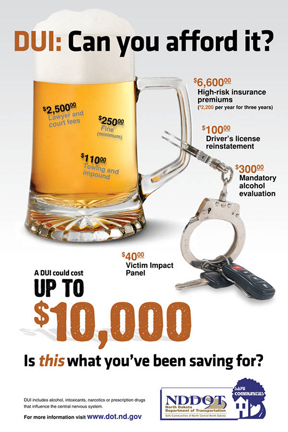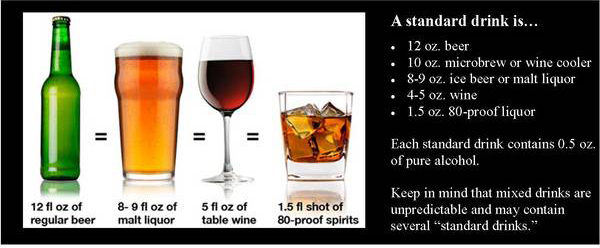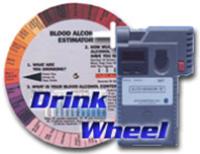 If you choose to make the decision to drink alcohol, remember, your only safe and legal option is to not drink until the age of 21. However, it is important to familiarize yourself with the facts about alcohol BEFORE you choose to drink.
If you choose to make the decision to drink alcohol, remember, your only safe and legal option is to not drink until the age of 21. However, it is important to familiarize yourself with the facts about alcohol BEFORE you choose to drink.
- Fact 1: Students drink less as they progress through college. Heavy drinking is most common among first-year college students.
- Fact 2: Alcohol is a depressant drug that slows down the central nervous system.
- Fact 3: At low doses, alcohol temporarily increases the heart rate, creating a mildly stimulating effect.
- Fact 4: The liver removes alcohol from the bloodstream at a constant rate of about one drink per hour. When alcohol is consumed at a faster rate, the liver cannot keep up and BAC (blood alcohol concentration) continues to rise.
- Fact 5: The rate at which alcohol leaves the system is constant regardless of gender, body type or size.
- Fact 6: A BAC of .15% makes a fatal car crash 380 times more likely.
It is essential to track how much alcohol you are actually drinking to help you estimate your BAC (blood alcohol concentration). Some drinks may only appear to be ‘one drink’, but can contain as many as five standard drinks. To calculate your BAC, you need to know what a standard drink is...

Basically, a BAC is your level of intoxication and is usually expressed as a percentage of your total blood volume. Your BAC rises when you take in alcohol more quickly than your body can remove it. As your BAC rises, impairment becomes more evident (poor decision making, emotional responses, reflexes, motor coordination and balance). At high levels, the involuntary function (breathing, reaction, etc.) of your body can be impacted leading to passing out, blacking out or even an overdose (dying). It is important to remember that SEVERAL factors influence your BAC, including:
- Weight
- Gender
- Rate of drinking
- Other Rx or non-Rx medications
| The Drink Wheel (Online BAC Calculator) |
R-U-Buzzed? BAC Calculators for iPhones |
|---|---|
|
|
 |
Most of us think that more of something is better. However, that isn’t always true.
Common Reasons for Drinking

- ‘Buzzed’ feeling
- Relaxation
- Socializing
Common Downfalls of Drinking
- Hangovers
- Missing class
- Lower grades
- Poor decision-making
Did you know that almost ALL of the desired aspects of drinking happen at low BACs (.03-.05) while most negative things happen at high BACs (.06+)? Why?
Alcohol is biphasic--meaning that alcohol, at low doses, is a mild stimulant and at higher doses is a depressant. A person who drinks should plan to not drink past the point of diminishing returns. This occurs when one more drink will not enhance the enjoyable effects of alcohol, but instead raise the harmful effects of impairment
Remember, everyone’s BAC rises at different rates; however, everyone sobers up at approximately the same rate. A cold shower, coffee, food, exercise or medicine will not sober a person up faster.
If you go to bed at 2 a.m. with a BAC of .20%, your next 14 hours will look like this:
| Time | Activity | BAC |
|---|---|---|
| 2 a.m. | In bed, lightheaded and confused | .200 |
| 3 a.m. | Nauseous, unable to sleep | .185 |
| 4 a.m. | Very restless | .170 |
| 5 a.m. | Sleeping, but not well | .155 |
| 6 a.m. | Sleeping | .140 |
| 7 a.m. | Getting ready for class | .125 |
| 8 a.m. | Drive to class | .110 |
| 9 a.m. | In class, trouble focusing | .095 |
| 10 a.m. | Judgement still impaired | .080 |
| 11 a.m. | Mind still hazy, tired | .065 |
| 12 p.m. | Not hungry, cottonmouth | .050 |
| 1 p.m. | In afternoon class, still unfocused | .035 |
| 2 p.m. | Head clearing | .020 |
| 3 p.m. | Feeling a little better | .005 |
| 4 p.m. | Sober at last, but not fully recovered | .000 |
Consumed at high doses, alcohol can be deadly. Knowing the signs and symptoms of an alcohol overdose (alcohol poisoning) is important.
Signs of an Alcohol Overdose
- Person cannot be woken up
- Slow breathing (less than 8 breaths per minute)
- Irregular breathing (more than 10 seconds between breaths)
- Cold, clammy, pale or bluish skin
- Vomiting
- Seizures
What to Do
- Call 911 IMMEDIATELY.
- Don’t wait for all of the symptoms to be present.
- Just one sign may be an indication of an alcohol overdose.
- Turn the person on his or her side to avoid choking.
- If their breathing stops, perform CPR.
- Stay with the person until help arrives.
Important to Note: North Dakota has a medical amnesty law for alcohol-related emergencies. ND Century Code states: "An individual under twenty-one years of age is immune from criminal prosecution under this section if that individual contacted law enforcement or emergency medical services and reported that another individual under twenty-one years of age was in need of medical assistance due to alcohol consumption, provided assistance to the individual in need of medical assistance until assistance arrived and remained on the scene, or was the individual in need of medical assistance and cooperated with medical assistance and law enforcement personnel on the scene. The maximum number of individuals that may be immune for any one occurrence is five individuals."
More information can be found at www.legis.nd.gov/cencode/t05c01.pdf.

